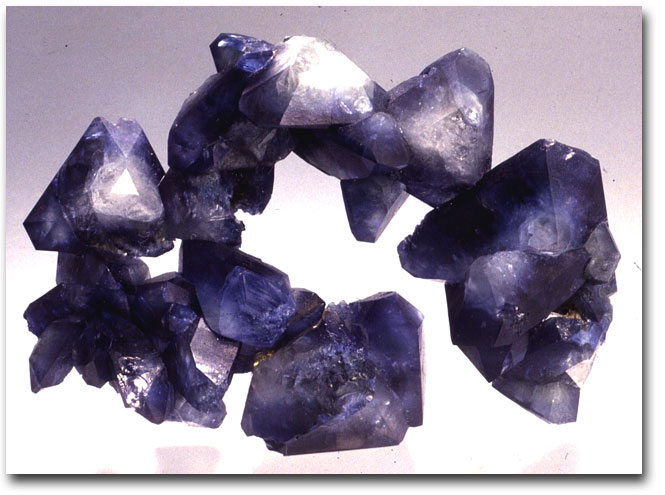Benitoite: California's State Gem
|

Benitoite specimen in the collection of the Natural History Museum of Los Angeles County. |
On October 1, 1985, benitoite (pronounced beh-nee-tow-ite) was designated as the official state gem by the California legislature. Benitoite, a barium titanium silicate, can occur in rich blue crystals that are as striking and flawless as the finest sapphires. Gem quality benitoite is found only in a small area of San Benito County, California. Benitoite has never been found in quantity or as crystals much larger than 5cm across. The scarcity of this beautiful gem makes it primarily a collector’s item. However, a minor amount of high quality benitoite is used to help align and adjust electron microprobe beams.
Benitoite was discovered in 1906 by J.M. Couch at the now well-known Benitoite Gem Mine locality in San Benito County. The mineral was thought to be sapphire, but jewelers determined that it was not. In 1907, George D. Louderback, a mineralogy professor at the University of California at Berkeley identified it as a new mineral species, and named it benitoite after the river, county, and nearby mountain range where it was found.
Benitoite crystals occur in a wide range of colors including heliotrope, pink, white, several shades of blue, and colorless. A variety of colors and hues in a crystal is common. Color is often zoned and is most intense toward the edges of the flattened triangular crystals and pale, white, or colorless in the center. The large majority of crystals are translucent and have pale blue or white centers with deep blue outer rims. A small amount of iron (0.05%) detected by emission spectroscopy may occur in deep blue-purple crystals. The violet-blue in some crystals is thought to be caused by titanium sesquioxide.
Mineralogists group all crystals into six systems that are further divided into 32 classes. These systems and classes are based on the symmetry or lack of symmetry in the arrangement of crystal faces. The hexagonal system, to which benitoite belongs, theoretically has 12 classes. Although 10 of the 12 classes were known to occur in nature, two of them remained to be found. The investigators discovered that benitoite belonged to one of these missing classes. It is the only naturally occurring representative of the ditrigonal-dipyramidal class. The most common crystal habit of benitoite is distinctively pyramidal. It also occurs in a variety of other crystal habits.
Benitoite fluoresces a bright deep sky blue under short wave ultraviolet light and x-rays. it is one of the most beautiful fluorescent minerals. At the tips of many benitoite crystals, the blue daylight color of the crystal sometimes gives way to white. These white sections frequently fluoresce pink-red, sometimes fairly brightly, under long wave ultraviolet light. Many benitoite crystals also exhibit strong pleochroism visible to the naked eye. A crystal may look blue if seen through the acute faces of the rhombohedron and, when viewed through the obtuse faces it may look colorless.
Benitoite Facts
Color and Luster: Blue, purple, heliotrope, pink, white, colorless, often varicolored in a single crystal. Transparent, vitreous, streak uncolored. Fluoresces bluish under short-wave ultraviolet light and x-rays.
Mode of Occurrence: Occurs in a drill core taken near Rush Creek in Fresno County, as small grains from a drill hole in the Lazard area of Lost Hills, Kern County, and as superb crystals at two locations near the headwaters of the San Benito River, San Benito County. It also occurs in Eocene sands in southwest Texas and in sands of the Owithe Valley, Belgium.
Environment of Formation: Occurs as crystals in veins in the brecciated zone of a blue schist emplacement in serpentine. It is found with neptunite and joaquinite and is encased in a matrix of white natrolite.
Composition: BaTiSi3O9 (Barium Titanium Silicate)
Crystal Form: Hexagonal system, Ditrigonal-Dipyramidal class
Hardness: 6 - 6½
Luster: Vitreous to subadamantine
Specific Gravity: 3.64 - 3.69 (measured), 3.688 (calculated)
Cleavage: Poor pyramidal indistinct, fracture concoidal or uneven, brittle.
Habit: Crystals pyramidal, stubby, or tabular, usually flattened along the c-axis, somewhat triangular in shape. |
